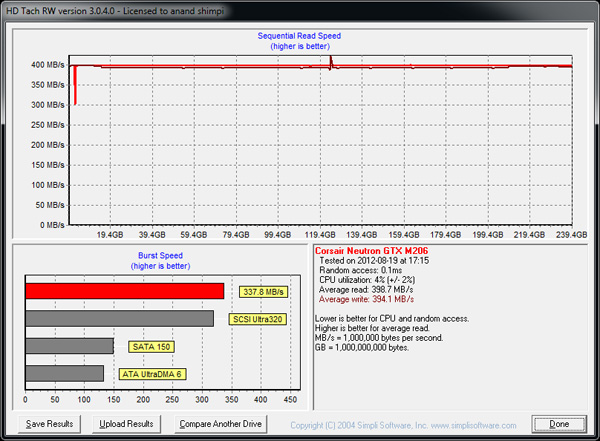Corsair Neutron GTX SSD Review (240GB): Link A Media Controller Tested
by Anand Lal Shimpi on August 20, 2012 6:00 AM EST- Posted in
- Storage
- SSDs
- Corsair
- Neutron
- Link a Media
Performance Over Time & TRIM
Over time SSDs can get into a fairly fragmented state, with pages distributed randomly all over the LBA range. TRIM and the naturally sequential nature of much client IO can help clean this up by forcing blocks to be recycled and as a result become less fragmented. Leaving as much free space as possible on your drive helps keep performance high (20% is a good number to shoot for), but it's always good to see how bad things can get before the GC/TRIM routines have a chance to operate. As always I filled all user addressible LBAs with data, wrote enough random data to the drive to fill the spare area and then some, then ran a single HD Tach pass to visualize how slow things got:
Performance drops pretty low but it's not terrible at above 50MB/s. The flat line around 230MB/s both at the starting and higher LBAs is a bit peculiar, but we could just be seeing some pinning of data that the controller thinks is important for whatever reason. Read performance is also pretty heavily impacted, being cut in more than half once the drive is in this state. A quick format of the drive triggers TRIM which restores performance to new:
The Neutron GTX is reasonably resilient but behaves like a normal SSD in that if you throw a lot of random writes at it, you will see steady state performance well below 100MB/s. Most client usage models, particularly if you leave enough free space on the drive (I like to shoot for ~20% free space), shouldn't get into this state even after years of use.












36 Comments
View All Comments
name99 - Tuesday, August 21, 2012 - link
"Load power consumption is much more competitive. It's not what I would consider low, but it's not unreasonably high either."Well I guess we all have different opinions...
IMHO the only number that matters is whether the maximum power draw (usually sequential writes) is below 2.5W. Below 2.5W and you know you can use it safely in a USB2 enclosure. Above that and it will appear to work but fail at random times.
You might think you only want to use this drive INSIDE a laptop. OK, if you are SURE of that. My experience is that drives move with time from one location to another, and it sucks if I have to throw them away when they're still good.
You might think you will only want to use this drive in a USB 3 enclosure (and now you have 4.5W to play with). OK.... but again life's going to suck if for some reason you want to use that drive on a USB2 machine.
IMHO SSD architects are behaving like Pentium4 architects, doing what they like while ignoring power issues. This is a path that does not end well. We'll already at the point where nobody gives a fsck about the difference between a streaming rate of 300MB/s and 330 MB/s --- but people DO care about battery life, and they do care about devices that are gratuitously heating up their rooms and warming their palms.
At some point point, these architects need to grow up and follow Intel down the path of speed at reasonable power, not speed at any power whatsoever.
KAlmquist - Monday, August 27, 2012 - link
Yes, it is disappointed to see SSD designs get worse over time in terms of power consumption. The Samsung 830 does a good job of holding down power usage when idle, but can draw more than the 4.5W limit of USB 3.0 when busy.dishayu - Wednesday, August 22, 2012 - link
Can we have the Plextor M5 Pro review please? I can't make up my mind if i should just pick up a Samsung 830 or wait for M5 Pro.Mr Perfect - Wednesday, August 22, 2012 - link
I know this sounds archaic, but could you throw a mechanical laptop drive into the power charts? At this point in time I honestly have no idea if these SSDs even have a power advantage over a modern spinner. It's hard to tell if a "bad" SSD is still better then a good mechanical, battery wise.Visual - Monday, August 27, 2012 - link
Unfortunately I do not have any media that I can link. ;)killabee_me - Wednesday, September 19, 2012 - link
Hi Anand,The test results didn't make it into Anandtech SSD Bench for some reason.
Could you make sure they get there?
Thanks.